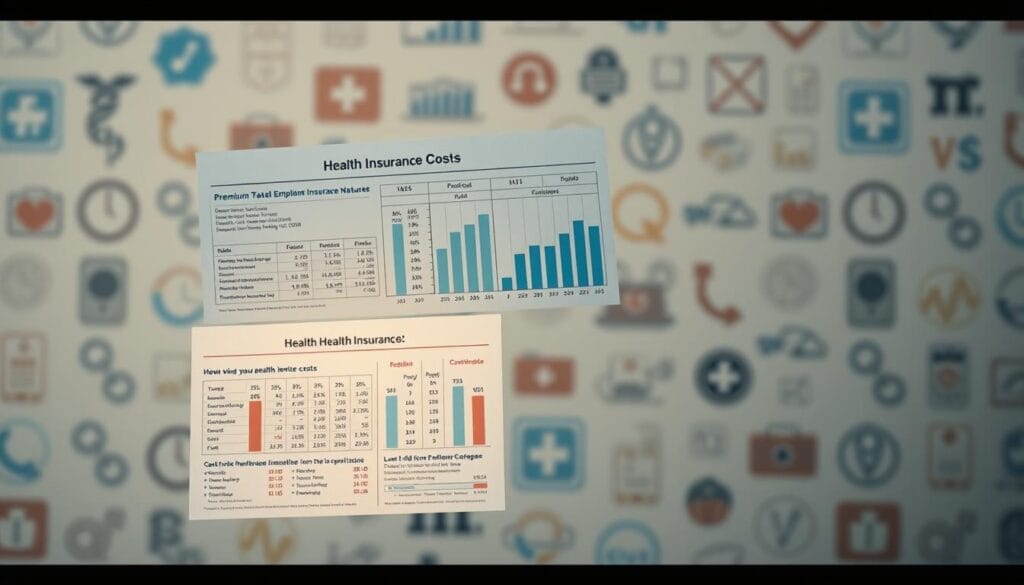Nearly 42% of self-employed professionals lack adequate medical coverage, leaving them vulnerable to soaring healthcare costs. For gig workers, securing tailored protection isn’t just a choice—it’s a financial safeguard. The evolving landscape of independent work demands solutions that align with irregular incomes and variable employment statuses.
Traditional employer-sponsored benefits rarely apply to freelancers, making specialized policies critical. Costs vary significantly by age: a 40-year-old may pay around $575 monthly for an ACA marketplace plan, while younger individuals often qualify for lower premiums. Self-employed workers can deduct 100% of these expenses, reducing taxable income by thousands annually.
Subsidies via HealthCare.gov further ease the burden, with 68% of enrollees paying under $75 monthly after credits. This guide analyzes 2025’s most adaptable policies, prioritizing flexibility, affordability, and comprehensive care. From catastrophic plans to expanded Medicaid eligibility, strategic selection ensures stability in an unpredictable gig economy.
Key Takeaways
- Specialized coverage addresses gig workers’ unique income fluctuations and benefit gaps.
- Average ACA premiums range from $300-$800 monthly, influenced by age and location.
- Full premium deductions are available for self-employed individuals at tax time.
- Subsidies through HealthCare.gov can reduce costs by up to 90% for eligible applicants.
- Catastrophic plans offer budget-friendly options for those under 30 or with hardship exemptions.
Introduction: The Evolving Health Insurance Needs of Gig Workers

Rising deductibles and specialty care costs create unique challenges for those without employer-sponsored benefits. Independent professionals now spend 25% more on medical expenses compared to traditionally employed peers, according to recent market analyses. This gap highlights the urgency for adaptable coverage models in an economy where 36% of U.S. workers participate in freelance or contract roles.
Why Protection Matters for Non-Traditional Employment
Comprehensive medical safeguards transform unpredictable risks into manageable costs. A single emergency room visit averages $2,200 without coverage—a figure that could destabilize finances for those with irregular incomes. Government programs like Medicaid and CHIP provide vital support, with 15 states expanding eligibility criteria in 2024 to include more self-employed applicants.
Strategic use of premium tax credits reduces monthly payments for 4 out of 5 marketplace enrollees. Cost-sharing reductions further lower out-of-pocket maximums for eligible individuals. When evaluating policies, focus on three core elements:
- Deductible flexibility to match income variability
- Network adequacy for preferred care providers
- Coinsurance rates that align with projected healthcare usage
Marketplace tools enable side-by-side comparisons of these factors, though third-party advisories often provide deeper plan insights. Regular policy reviews ensure continued alignment with changing health requirements and financial circumstances.
Understanding the Insurance Landscape for Self-Employed Individuals

Over 23% of freelancers now purchase coverage through ACA marketplaces, with Silver-tier plans averaging $450 monthly for 35-year-olds. Costs rise to $680 for those aged 50, reflecting age-based pricing structures. Strategic financial planning requires balancing premium affordability with coverage scope, particularly for those managing irregular cash flow.
Analyzing Cost Structures and Subsidy Options
Marketplace subsidies dramatically alter affordability equations. A single filer earning $45,000 annually could qualify for $280 monthly premium tax credits, reducing a $550 Silver plan to $270. Cost-sharing reductions further lower deductibles by 40% for eligible enrollees. Key factors influencing subsidy eligibility include:
- Household income relative to federal poverty levels
- Regional healthcare cost variations
- Family size and dependent coverage needs
Tax Deductions and Business Expense Benefits
Self-employed professionals can deduct 100% of premium costs from federal taxes, potentially saving $2,800 annually for those in the 22% tax bracket. This deduction applies even if claims exceed premiums paid. “Medical expense write-offs remain one of the most underutilized tools for independent contractors,” notes IRS Publication 535.
Comparing deductible strategies reveals clear advantages. A freelancer paying $6,000 yearly in premiums could reduce taxable income by that amount, versus traditional employees who can’t deduct employer-sponsored plan costs. Regular reviews of subsidy qualifications and tax implications ensure ongoing financial optimization.
Best Health Insurance Plans for Gig Workers 2025

Modern independent professionals increasingly prioritize tech-enabled solutions when selecting care strategies. Digital-first providers leverage mobile platforms and AI-driven tools to simplify enrollment and claims processing. Traditional insurers counter with decades of network-building expertise, creating distinct value propositions for different user needs.
Digital-First Providers vs. Traditional Insurers
Platforms like Oscar Health redefine accessibility through intuitive apps offering instant policy comparisons and virtual consultations. Their systems automatically match users with coverage options based on prescription needs and preferred providers. However, regional network limitations may require supplemental gap policies in some areas.
Blue Cross Blue Shield exemplifies traditional insurers’ strengths, with 96% of U.S. hospitals accepting their plans. Members gain direct access to specialists without referrals—a critical advantage for chronic condition management. Premiums average 18% higher than digital equivalents, but broader networks reduce out-of-network surprise bills.
Key Features and Coverage Comparisons
Telemedicine availability separates modern plans from legacy models. Digital providers include unlimited virtual visits in base packages, while traditional carriers often charge per consultation. Preventive care shows similar inclusion rates, but app-based services streamline appointment scheduling through integrated calendars.
Cost structures reveal tradeoffs: digital-first options have lower deductibles ($1,500 average) versus traditional plans’ $3,000 median. However, prescription drug coverage tiers vary significantly. “Members should cross-reference their regular medications against formularies before enrollment,” advises a recent industry white paper.
Evaluating these models requires balancing immediate cost savings against long-term care accessibility. Gig professionals with predictable medical needs may favor digital efficiency, while those requiring specialized treatments often benefit from established networks.
Innovative Health Insurance Options for Digital Natives

Recent surveys show 78% of independent contractors prioritize mobile-first solutions when managing medical coverage. Tech-enabled platforms now dominate the market, offering intuitive tools that align with on-demand lifestyles. These systems eliminate paperwork delays and provide real-time access to critical benefits.
User-Friendly Apps and Telemedicine Services
Leading insurers integrate AI chatbots and symptom checkers into their apps, resolving 65% of routine inquiries without human agents. Virtual consultations operate 24/7, with average wait times under 4 minutes. Same-day prescription delivery and automated claim submissions further simplify care coordination.
A 2024 industry report noted platforms with streamlined claims processes reduce administrative tasks by 40%. Members upload documents via smartphone cameras, while machine learning verifies submissions instantly. This efficiency lowers overhead, passing savings to users through reduced premiums.
Streamlined Claims and Virtual Care Benefits
Digital-first providers partner with regional clinics to expand network access without traditional brick-and-mortar costs. While major cities see 90% coverage rates, rural users may still face gaps. Traditional carriers counter with nationwide hospital alliances but often lack app-based convenience.
Cost comparisons reveal tech-driven policies save freelancers $1,200 annually through preventive care incentives. “Automated reminders for check-ups and vaccinations improve long-term outcomes,” states a telehealth white paper. For those seeking affordable coverage options, hybrid models blend virtual accessibility with localized provider networks.
Traditional Providers and Preventive Care Advantages

Established insurers deliver stability through nationwide networks that adapt to mobile lifestyles. Blue Cross Blue Shield (BCBS) covers care in 96% of U.S. counties, offering seamless transitions for professionals working across state lines. This geographic flexibility reduces administrative hurdles when relocating or accepting temporary contracts.
National Networks with Established Insurers
BCBS and similar companies maintain partnerships with over 90% of primary care providers. Members avoid surprise bills through pre-negotiated rates at most facilities. For those managing premiums, these plans often include tiered pricing based on regional cost differences.
Integrated systems connect medical records across providers, ensuring continuity for chronic conditions. A BCBS representative notes, “Our MyBlue platform lets users transfer prescriptions instantly between 50,000 pharmacies nationwide.” This reliability proves critical when balancing unpredictable work schedules.
Comprehensive Preventive Care Frameworks
Traditional providers excel in covering annual check-ups, vaccinations, and screenings at 100% cost. BCBS plans average 38 preventive services versus 22 in digital-first alternatives. Three tips for maximizing these benefits:
- Verify coverage for age-specific screenings before enrollment
- Use telehealth options for routine consultations
- Combine preventive care with retirement savings strategies for holistic financial security
These models particularly benefit freelancers needing consistent access to specialists. While premiums average 12% higher than digital plans, reduced out-of-pocket costs for ongoing treatments often offset initial expenses.
Leveraging the Health Insurance Marketplace for Personalized Plans

Over 15 million Americans enrolled through HealthCare.gov in 2024, with 87% receiving financial assistance. This platform empowers self-employed individuals to compare coverage options from major providers like Blue Cross Blue Shield, tailoring plans to specific needs such as vision care or prescription drug coverage. Personalized filters sort policies by deductible ranges, network size, and subsidy eligibility.
Maximizing Savings Through Financial Assistance
Premium tax credits reduce monthly costs by scaling with income. A freelancer earning $55,000 annually could qualify for $320 in credits, cutting a $600 Silver plan to $280. “Subsidies transform unaffordable premiums into manageable expenses,” states a HealthCare.gov advisory report. Eligibility hinges on household income relative to federal poverty levels—currently $14,580 for single filers.
Blue Cross Blue Shield exemplifies marketplace efficiency, offering tiered plans with vision and dental add-ons. Their expanded networks provide access to 92% of specialists nationwide. Cost-sharing reductions further lower deductibles for those earning below 250% of poverty thresholds.
Three critical steps ensure optimal plan selection:
- Calculate projected income using IRS Form 8962 guidelines
- Compare total yearly costs (premiums + out-of-pocket maximums)
- Verify prescription formularies and specialist availability
Regular marketplace reviews align coverage with life changes. Combined with long-term financial security strategies, this approach creates stability for unpredictable earning cycles. Enrollment specialists recommend updating applications whenever income fluctuates by 10% or more.
Balancing Premiums, Deductibles, and Cost Efficiency

Effective cost management hinges on understanding how premium payments interact with out-of-pocket responsibilities. A $300 monthly plan with a $7,000 deductible might initially seem affordable but could prove costly for frequent care seekers. Conversely, higher premiums often correlate with lower deductibles—a critical consideration for those anticipating regular medical needs.
Evaluating Premium Costs Across Different Plans
Marketplace options reveal stark contrasts in pricing structures. Bronze-tier policies average 40% lower premiums than Gold plans but carry deductibles exceeding $6,000 annually. Self-employed professionals should calculate their expected healthcare usage against these variables. Telemedicine inclusion and prescription coverage tiers further influence true affordability.
Managing Out-of-Pocket Expenses Effectively
Coinsurance rates dramatically impact long-term costs. A 20% coinsurance requirement on a $10,000 procedure adds $2,000 to deductibles. Short-term policies offer temporary relief with premiums under $200 monthly but exclude pre-existing conditions. “Always compare the lifetime value of coverage, not just upfront costs,” advises a Kaiser Family Foundation analysis.
Integrating retirement planning strategies with health expenditure analysis creates financial synergy. High-deductible plans paired with HSAs allow tax-advantaged savings, while marketplace subsidies reduce immediate burdens. Regular policy audits ensure alignment with evolving income levels and medical needs.
Exploring Specialized Insurance Options for Gig Workers

Temporary coverage solutions now serve 29% of independent contractors during career transitions. These niche products address fluctuating income cycles while maintaining essential safeguards against medical emergencies.
Short-Term Health Insurance Plans
Limited-duration policies provide 3-12 months of basic protection at 40% lower premiums than ACA-compliant options. Ideal for freelancers between contracts, these plans cover urgent care visits and hospitalization. “They act as financial airbags during coverage gaps,” explains a National Association of Insurance Commissioners report.
However, pre-existing conditions and preventive care often remain excluded. Younger professionals with minimal medical history typically benefit most from this model. Renewal restrictions apply in 32 states, requiring careful review of eligibility terms.
Family Floater and Critical Illness Coverage
Family-centric policies consolidate protection under single premiums, reducing costs by 25% compared to individual plans. Critical illness riders offer lump-sum payouts for diagnoses like cancer or heart disease—funds usable for treatments or income replacement during recovery.
Three factors determine suitability:
- Dependent age ranges and their healthcare needs
- Regional availability of cashless hospitalization networks
- Portability across state lines during work assignments
Platforms like Cigna and Aetna now offer modular group health insurance models for freelancer collectives. These pool risks across members, achieving premium reductions akin to employer-sponsored plans. Hybrid structures combine catastrophic coverage with telemedicine benefits, creating adaptable safety nets for unpredictable careers.
Maximizing Financial Benefits for the Self-Employed
Self-employed professionals can transform healthcare costs into strategic advantages through specialized financial tools. Two mechanisms stand out: tax-advantaged savings vehicles and premium deductions. These approaches work synergistically to reduce both immediate expenses and long-term tax liabilities.
Utilizing Health Savings Accounts (HSAs)
HSAs offer triple tax benefits: contributions are deductible, growth tax-free, and withdrawals for qualified expenses penalty-free. When paired with high-deductible health plans, these accounts enable strategic budgeting for medical costs. Blue Cross Blue Shield provides HSA-compatible policies with integrated contribution tracking through their member portals.
A freelancer contributing $3,000 annually could save $750 in taxes (25% bracket) while building emergency reserves. “HSAs function as retirement supplements—funds unused by age 65 convert to traditional IRA equivalents,” explains a Treasury Department report.
Tax Advantages and Business Expense Deductions
Premium payments qualify as above-the-line deductions, reducing adjusted gross income directly. For a sole proprietor paying $500 monthly, this translates to $6,000 in deductible expenses annually. Established providers like Blue Cross Blue Shield simplify documentation with detailed premium statements.
Combining deductions with HSA contributions amplifies savings. A consultant earning $80,000 could lower taxable income by $12,000 through these strategies. Regular consultations with tax professionals ensure compliance while maximizing benefits unique to self-employment structures.
Actionable Tips for Selecting the Right Coverage
Navigating coverage options requires a systematic evaluation of plan structures and provider capabilities. Start by auditing your typical healthcare usage—telemedicine frequency, prescription refills, and specialist consultations. This baseline informs deductible tolerance and network requirements.
Comparing Policy Features and Provider Networks
Blue Shield and Kaiser Permanente exemplify contrasting approaches. Blue Shield’s nationwide partnerships suit mobile professionals, while Kaiser’s integrated systems streamline care for those prioritizing preventive services. Three evaluation criteria:
- Match deductibles to projected annual medical expenses
- Verify if preferred doctors participate in provider directories
- Analyze prescription coverage tiers for regular medications
Marketplace tools simplify side-by-side comparisons, but third-party advisors often identify hidden cost factors. “Network adequacy matters more than premium savings for chronic condition management,” states a recent industry analysis.
Leveraging Group Plans and Membership Benefits
Freelancer unions and professional associations frequently negotiate group health insurance rates 15-20% below individual market prices. For example, the Freelancers Union partners with insurers to offer portable coverage across state lines.
Established providers like Blue Shield extend discounts through alumni groups or trade organizations. Kaiser Permanente counters with wellness incentives—up to $200 annual credits for completing health assessments. Cross-reference these opportunities with comprehensive coverage strategies to maximize protection across multiple risk categories.
Regularly revisit marketplace listings during open enrollment periods. Subsidy thresholds and plan details evolve annually, requiring updated assessments to maintain cost-efficiency.
Conclusion
The dynamic nature of non-traditional employment demands adaptable coverage strategies. Freelancers and independent contractors now have more tailored options than ever, from subsidized marketplace policies to group health arrangements through professional collectives. Average monthly costs between $300-$800 highlight the value of strategic planning, particularly when tax deductions and premium credits are maximized.
Specialized options for freelancers address fluctuating incomes through adjustable deductibles and telemedicine integrations. Platforms offering critical illness protection add crucial safeguards against unpredictable medical emergencies. Those operating as small businesses can further reduce expenses by leveraging ACA subsidies and HSA tax advantages.
Proactive evaluation remains essential. Compare provider networks, prescription formularies, and out-of-pocket limits annually. Established insurers and digital-first platforms each offer distinct advantages depending on care priorities.
Independent professionals should consult licensed advisors to navigate evolving group health opportunities and state-specific regulations. Immediate action ensures continuous protection as the gig economy reshapes traditional benefit models. Explore marketplace tools today to align coverage with both current needs and long-term financial goals.

